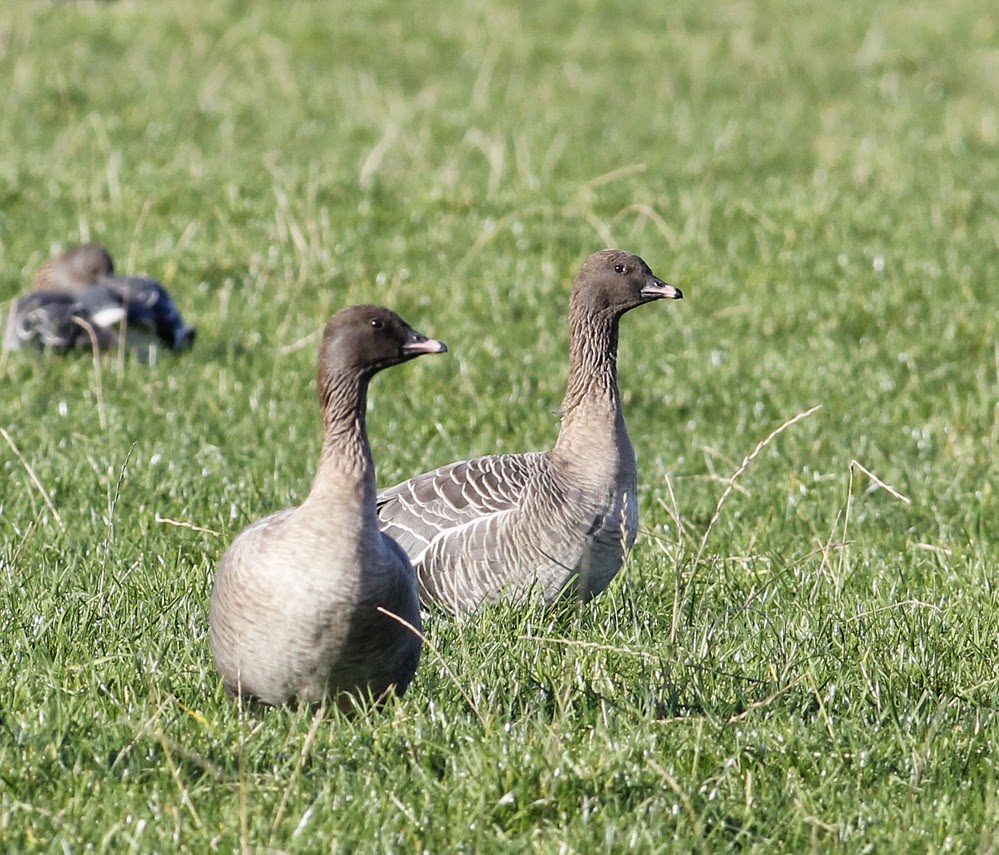There have been times during the last month of wind, rain and grey skies when I thought I’d never get out birding or ringing ever again. November will surely be one of the most dismal on record. My last ringing session was on 4th November, and although our ringing site at Oakenclough has been topped with bird food regularly the dreadful weather has not allowed any further ringing. Today was my turn with the buckets, one of Nyger and the other of mixed seed where I found that a reasonable number of Chaffinches, Goldfinches and Blackbirds had not deserted the site.
Blackbird
But once again the morning was too blowy for ringing so I made my way back to Pilling and some birding. At Fluke Hall the flooded stubble held approximately 140 flighty Lapwings and just 2 Pied Wagtails where the tracks through the soft, peaty ground told me the field had seen regular disturbance from the shooters’ visits.
Pilling Morning
Eight Whooper Swans flew over and headed south of the wood to a spot unknown and out of sight. Meanwhile a walk through the wood revealed a Brambling or two in the treetops among a handful of Chaffinch. A Brambling’s nasal wheezing is quite unlike the typical sounds made by its close cousin the Chaffinch, and once learned a Brambling’s call is never forgotten. Otherwise the wood was quiet except for the usual mix of titmice and several Blackbirds.
Brambling
Near Lane Ends a large party of approximately 1400 Pink-footed Geese fed in a roadside field, the geese keeping a safe and suitable distance from peering eyes and slowing vehicles. I was 125 yards away where I “grilled” them for a while from the wound down car window but failed to find any interlopers like Barnacle, White-fronted or Bean Geese. At the present time there are many more geese frequenting fields within 800 yards of my home but there are few roads or stopping places from which to take a closer look. Our winter visiting Pinkfeet use their local knowledge and experience gained over a number of years to as much as possible stay out of sight and out of mind while keeping one eye on quick escape from predators, especially those with guns. The average lifespan of a Pink-footed Goose is eight years, the longevity record is more than 38 years, ample time to learn the ropes.
Pink-footed Geese
Just along from Lane Ends were 10 Little Egrets feeding in a grassy but wet field, the meadow more sheltered than the marsh where the egrets are more usually found. From the sea wall came the sound of an unseen Little Grebe on the pool hidden from view, and out on the marsh a distant Peregrine.
I stopped at Wrampool Brook to find the flock of circa 120 Linnets in the set-aside field together with a fence-hopping Kestrel. It’s not only a good weedy field for the Linnets but there’s a handy ditch with mammal prey for both owls and Kestrels.
Kestrel
A look at Braides Farm found two Buzzards and two Carrion Crows in the area of the farmer’s pile of refuse again. The Buzzards were fence-hopping while searching the ground from above and below and also the midden for insects and worms, as were the crows. I think that all were looking to steal off each other but I imagine the Buzzards would come out on top of any dispute.
Buzzard
Buzzard
The wind began to pick up again. There's yet another Yellow Weather Warning for the weekend.
No problem, there will be news, views and more pictures very soon with Another Bird Blog, so please return another day.
Linking today to Stewart's World Bird Wednesday, Anni's Birding and Eileen's Saturday.
Linking today to Stewart's World Bird Wednesday, Anni's Birding and Eileen's Saturday.


































































.jpg)













